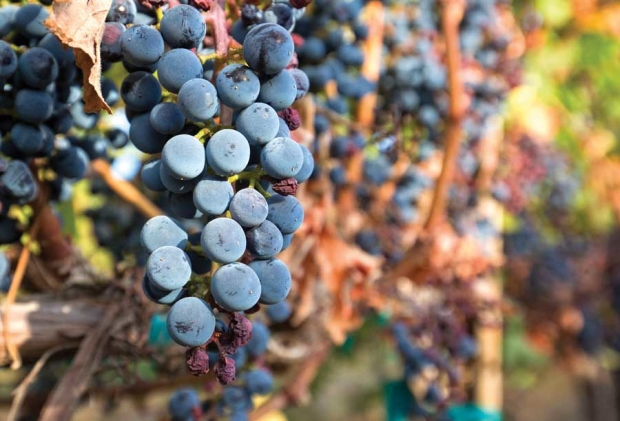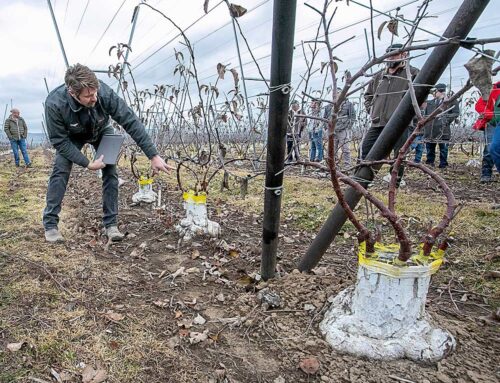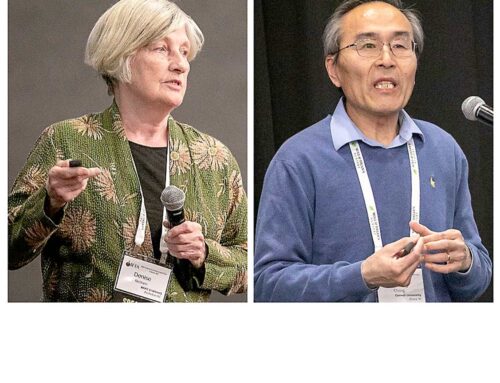
Cabernet Sauvignon grapes are ready for harvest at Cold Creek Vineyard in 2015. The vineyard has 132 acres in Cabernet clones. “We know clones bring different attributes that can contribute to different wines,” says vineyard manager Joe Cotta. (TJ Mullinax/Good Fruit Grower)
Consumers want variety, and wine consumers are growing increasingly sophisticated. The trend is driving winemakers to seek new ways to differentiate their wines in a crowded marketplace.
Some are aiming to stand out by returning to their roots. Clonal selection is key to viral resistance and yield. The clone also can impart different characteristics to the grapes and wine, whether it’s fruit size, acidity or tolerance to heat or cold.
As some wineries turn to naming the clone as part of their marketing plans, grape growers are examining the benefits and detriments of different clones in the vineyard.
A panel of growers from four Washington wine grape growing regions shared their experiences with different Cabernet clones at the Washington Association of Wine Grape Growers conference in Kennewick, Washington, in February.
Their overall takeaway: Clone 8 produces the most consistent yields and fruit. And, despite the differences between clones, perhaps the bigger factor is soil and climate.
Red Mountain
Marshall Edwards, vineyard operations manager of Quintessence Vineyards in West Richland, Washington, oversees more than 300 acres of Cabernet, most of them planted on Clone 8 in Warden silt loam, Hezel loamy fine sand and Starbuck loam.
The vines have medium to good vigor and good production with good berry and cluster size, he said. The vines are color thinned.
Edwards leaves more buds and spurs to reach desired crop levels on Clone 21, planted in Warden silt loam, which produces small to average berry clusters and also has a color-thinning pass.
He also leaves more buds and spurs due to different soil types in a block of Clone 4, which sits in Warden silt loam and Hezel loamy fine sand.
The vines have medium vigor and good set, producing good berries and cluster size.
More average production comes from Clone 191/33 in Warden silt loam and Hezel loamy fine sand, with good set but small berry and cluster size, he said. Clone 2, too, produces small berry and cluster size compared to all other clones, but has good set when compared to Clone 169.
That’s the clone Edwards said poses the most struggles in the vineyard. It seems hard to set and produces small berries and loose clusters. It has the shortest growing period from veraison to harvest, he said, but it’s always the first Cabernet picked.
“All of these clones, they make the vineyard more interesting and they also make the wine more interesting,” he said. “I think these clones have their place.”
Wahluke Slope

Cabernet Sauvignon grapes are mechanically harvested at Cold Creek Vineyard south of Mattawa, Washington on October 1, 2015. (TJ Mullinax/Good Fruit Grower)
Chateau Ste. Michelle Wine Estates’ Cold Creek Vineyard, first planted in 1973 near Mattawa, Washington, underwent a 184-acre expansion from 2007 to 2014. Of that, 132 acres are in Cabernet clones, according to vineyard manager Joe Cotta.
“We know clones bring different attributes that can contribute to different wines,” Cotta said, adding that despite the challenges, clones offer another tool to improve quality and gain an edge on the competition.
Clones planted at the site include 2, 4, 6, 8, 10, 15, 21, 33, 169, 412 and 685. For the most part, all are planted the same way: 8-by-5-foot spacing on VSP.
Overall, the most commonly preferred clones at Cold Creek have been Clones 6 and 8, which are the lowest and highest yielding clones at the vineyard.
“I’m grateful to have Clone 8. It makes up one-third of our Cab expansion, and it’s just very versatile,” he said.
Clone 6 produces the smallest cluster weight and very loose clusters. “If we struggle with any of them, we struggle with this one if we want to get a high yield, but obviously, it’s highly preferred,” he said.
Cotta advised against thinning these two clones, as they are very easy to predict.
Clone 10 is also assumed to make high tier wines every year, he said, and Clones 169 and 33 will compete more as the vines get older. Clones 8, 15, 21 and 685 are the highest yielding clones, and 2, 4 and 412 are all middle of the pack.
Cotta said his only do-over would be less Clone 2.
“We prefer different clones in different years — not across the board, but you do see that variability,” he said. “The advantage is always there. There are always some clones that stand above the rest, and that allows you to improve your high-tier blend.”
Horse Heaven Hills
Jake Cragin is viticulturist and assistant manager for Winemakers LLC’s Horse Heaven Hills properties, Alder Ridge Vineyard and Canoe Ridge Vineyard, with about 421 acres dedicated to Cabernet. The majority of acreage is Clone 8, both for high-yield production and from feedback from winemaker clients.
Other clones include 2, 21 and 33, with the latter proving the least successful. “It’s been slow growing, we’ve had trouble getting it on the wire and getting any fruit, let alone quality fruit out of it,” Cragin said.
It also seems to be the preference for deer, he said. “It’s heavily depredated every year, and that doesn’t help when we’re already struggling with its growth, even with other Cabs nearby.”
Cragin said climactic and soil conditions — the vineyards have varying soils and geographic climates — seem to have a bigger effect than any clonal differences.
“When we try to isolate the variability of the block for location uniformity, we feel there’s enough variability that it hides any evidence of clonal differences,” he said.
Walla Walla
Sadie Drury, viticulturist for North Slope Management, manages multiple vineyard sites that sit at different elevations, including 50 acres of Cabernet on six clones.
“Site often trumps clone, and clones do vary on site,” she said. “But we notice more variation from block to block, based on row orientation, slope orientation, more than anything else.”
For instance, Clone 8 at Ferguson Vineyard is nothing like Clone 8 at Seven Hills Vineyard, despite just being up the road. And yet it’s still that classic clone that all others are compared to, she said.
“Mostly, our old plantings are all Clone 8,” she said. “If you love an old vines bottle of wine, it’s probably Clone 8, and it’s probably what sets the bar in Washington.”
Meanwhile, Clone 6 is the winemaker’s clone, not the grower’s clone, she said. “It’s hard to get good yields; we struggle to get over 2 tons per acre.” To deal with that, Drury said they leave more buds — anything to get more fruit — and are increasing nitrogen and water.
Clone 191 has produced fruit-forward wines that winemakers seem to love, and Clones 338 and 685 are younger but big yielders, she said.
“At the end of the day, we ask ourselves why do we plant all these clones: We want to maximize the site, but I also think it’s important not to put all of your eggs into one basket,” she said. “There isn’t any one clone for any one site. The best wine is from different clones blended together.” •
– by Shannon Dininny






[…] I found an interesting piece by Shannon Dininny on goodfruit.com about Cabernet Sauvignon clones in Washington State. Most of the discussion was regarding yields and reliability, as opposed to flavor. None-the-less it’s an interesting discussion if you want to nerd out about that stuff. https://www.goodfruit.com/wine-grape-growers-weigh-in-on-cabernet-sauvignon-clones/ […]